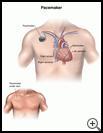
Pacemaker Syndrome
________________________________________________________________________
KEY POINTS
- A pacemaker is a battery-powered device placed under the skin of your chest to help your heart beat in a normal rhythm. With pacemaker syndrome, the coordination between your heart’s upper chambers and lower chambers is not working well, causing symptoms such as tiredness and weakness.
- Your healthcare provider may need to adjust your pacemaker to change the timing and strength of impulses.
- Ask your healthcare provider what symptoms or problems you should watch for and what to do if you have them.
________________________________________________________________________
What is a pacemaker?
A pacemaker is a battery-powered device placed under the skin of your chest to help your heart beat in a normal rhythm.
Normally, an electrical signal in your heart starts each heartbeat, causing the heart muscle to squeeze (contract). This signal starts in the upper right chamber of the heart (the right atrium). The signal then follows normal pathways to the upper left atrium and to the lower chambers of the heart (the ventricles). When your heart cannot beat regularly because of a problem with the electrical signal or damage to your heart, you may need a pacemaker. The pacemaker uses wires to deliver electrical signals to the heart, causing your heart to beat in a regular pattern.
What is pacemaker syndrome?
Pacemakers are placed to coordinate the pumping action of the heart chambers. When the chambers of the heart pump together in rhythm, the pumping action starts in the upper 2 chambers and then moves to the lower 2 chambers. When you have pacemaker syndrome, the coordination between the upper chambers and lower chambers is not working well. In other words, the timing is off and it causes symptoms, such as tiredness and weakness.
What is the cause?
Sometimes a pacemaker starts the pumping action in the lower chambers of the heart instead of the upper chambers. This decreases the amount of blood that the heart can pump to the body. The decreased blood flow may cause symptoms.
What are the symptoms?
Symptoms may include:
- Feeling tired or weak
- Abnormal heart beat
- Low blood pressure with lightheadedness
- Shortness of breath
- Heart symptoms you had before the pacemaker was implanted
How is it diagnosed?
Your healthcare provider will ask about your symptoms, activities, and medical history and examine you. You may have an ECG (also called an EKG or electrocardiogram), which measures and records your heartbeat. You may have an ECG while you are resting or while you exercise on a treadmill. You may also be asked to wear a small portable ECG monitor for a few days or sometimes a couple of weeks.
How is it treated?
Your healthcare provider may need to adjust your pacemaker to change the timing and strength of impulses. Changing these settings should improve most of the symptoms. Your provider may need to try several different settings to find what works best for you. In some cases, the pacemaker may need to be replaced with a different type of pacemaker.
How can I take care of myself?
Follow your healthcare provider's instructions. Ask your provider:
- How long it will take to recover
- If there are activities you should avoid and when you can return to your normal activities
- How to take care of yourself at home
- What symptoms or problems you should watch for and what to do if you have them
Make sure you know when you should come back for a checkup. Keep all appointments for provider visits or tests.


